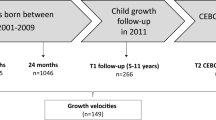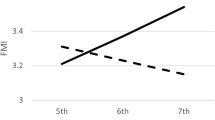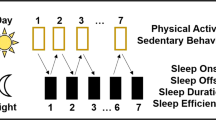Abstract
Objectives: To assess the extent that predilection for movement, as measured by a temperament questionnaire (activity temperament), contributes to nonresting energy expenditure and body composition in girls.
Design, Setting, and Participants: Baseline data for 196 premenarcheal non-obese girls aged 8–12 y were obtained from a longitudinal study of growth and development. The association of activity temperament with nonresting energy expenditure in girls with low and high levels of physical activity was evaluated, as was the association of activity temperament with body composition.
Measures: Maternal reports of child activity temperament were obtained by questionnaire. Nonresting energy expenditure was calculated as total energy expenditure (measured by doubly labeled water) minus resting energy expenditure (obtained by indirect calorimetry). Body composition was estimated by total body water. Questionnaires and activity diaries were used to assess physical activity and sedentary behavior.
Results: Higher activity temperament was associated with higher nonresting energy expenditure after multivariate control for weight, vigorous activity, walking and light activity, and television viewing, although activity temperament did not account for a large percentage of the variability in nonresting energy expenditure (partial squared correlation coefficient=0.03). In girls with physical activity levels below the median, high activity temperament was associated with a mean±s.d., nonresting energy expenditure of 310±138 kJ (74±33 kcal) above that of girls with a low activity temperament. Girls with a high activity temperament had less body fat than did girls with a low activity temperament (21.6 vs 24.5%, a difference of 2.9 percentage points; 95% confidence interval, 1.3–4.4 percentage points).
Conclusion: Predilection for movement, as measured by a temperament questionnaire, contributes to nonresting energy expenditure and may be useful in capturing an aspect of energy expenditure in population studies. The cross-sectional observation that girls with a high activity temperament were leaner than girls with a low activity temperament suggests that a constitutional predilection for movement may play a role in the development of obesity.
This is a preview of subscription content, access via your institution
Access options
Subscribe to this journal
Receive 12 print issues and online access
$259.00 per year
only $21.58 per issue
Buy this article
- Purchase on Springer Link
- Instant access to full article PDF
Prices may be subject to local taxes which are calculated during checkout


Similar content being viewed by others
References
Levine JA, Eberhardt NL, Jensen MD . Role of nonexercise activity thermogenesis in resistance to fat gain in humans. Science 1999; 283: 212–214.
Levine JA, Schleusner SJ, Jensen MD . Energy expenditure of nonexercise activity. Am J Clin Nutr 2000; 72: 1451–1454.
Thomas A, Chess S . Temperament and development. Brunner/Mazel Publishers: New York; 1977.
Bandini LG, Must A, Spadano JL, Dietz WH . Relation of body composition, parental overweight, pubertal stage, and ethnicity to energy expenditure among premenarcheal girls. Am J Clin Nutr 2002; 76: 1040–1047.
Must A, Dallal GE, Dietz WH . Reference data for obesity: 85th and 95th percentiles of body mass index (wt/ht2) and triceps skinfold thickness. Am J Clin Nutr 1991; 53: 839–846.
Bandini LG, Morelli JA, Must A, Dietz WH . Accuracy of standardized equations for predicting metabolic rate in premenarcheal girls. Am J Clin Nutr 1995; 62: 711–714.
Lifson N . Theory of use of the turnover rates of body water for measuring energy and material balance. J Theor Biol 1966; 12: 46–74.
Weir JB . New method of calculating metabolic rate with special reference to protein metabolism. J Physiol 1949; 109: 1–9.
Ogden CL, Kuczmarski RJ, Flegal KM, Mei Z, Guo S, Wei R, Grummer-Strawn LM, Curtin LR, Roche AF, Johnson CL . Centers for disease control and prevention 2000 growth charts for the United States: improvements to the 1977 National Center for Health Statistics version. Pediatrics 2002; 109: 45–60.
Halliday D, Miller AG . Precise measurement of total body water using trace quantities of deuterium oxide. Biomed Mass Spectrom 1977; 4: 82–87.
Schoeller DA, van Santen DW, Peterson DW, Dietz W, Jaspan J, Klein PD . Total body water measurement in humans with 18O and 2H labeled water. Am J Clin Nutr 1980; 33: 2686–2693.
Ching PLYH, Dietz WH . Reliability and validity of activity measures in preadolescent girls. Pediatr Exerc Sci 1995; 7: 389–399.
Ainsworth BE, Haskell WL, Leon AS, Jacobs DR Jr, Montoye HJ, Sallis JF, Paffenbarger, RS . Compendium of physical activities: classification of energy costs of human physical activities. Med Sci Sports Exerc 1993; 25: 71–80.
Sallis JF, Saelens B . Assessment of physical activity by self-report: status, limitations, and future directions. Res Q Exerc Sport 2000; 71 (2 Suppl): S1–S14.
Sirard JR, Pate RR . Physical activity assessment in children and adolescents. Sports Med 2001; 31: 439–454.
Levine J, Melanson EL, Westerterp KR, Hill JO . Measurement of the components of nonexercise activity thermogenesis. Am J Physiol Endocrinol Metab 2001; 281: E670–E675.
Bouchard C, Tremblay A, Despres J-P, Nadeau A, Lupien PJ, Theriault G, Dussault J, Moorjani S, Pinault S, Fournier G . The response to long-term overfeeding in identical twins. N Engl J Med 1990; 322: 1477–1482.
Schoeller DA, Jefford G . Determinants of the energy costs of light activities: inferences for interpreting doubly labeled water data. Int J Obes Relat Metab Disord 2002; 26: 97–101.
Levine J, Baukol P, Pavlidis I . The energy expended in chewing gum. N Engl J Med 1999; 341: 2100.
Buss AH, Plomin R . Temperament: early developing personality traits. Lawrence Erlbaum Associates: Hillsdale, NJ; 1984.
Zurlo F, Ferraro RT, Fontvielle AM, Rising R, Bogardus C, Ravussin E . Spontaneous physical activity and obesity: cross-sectional and longitudinal studies in Pima Indians. Am J Physiol 1992; 263 (2 Part 1): E296–E300.
Snitker S, Tataranni PA, Ravussin E . Spontaneous physical activity in a respiratory chamber is correlated to habitual physical activity. Int J Obes Relat Metab Disord 2001; 25: 1481–1486.
Kimm SYS, Glynn NW, Kriska AM, Barton BA, Kronsberg SR, Daniels SR, Crawford PB, Sabry ZI, Liu K . Decline in physical activity in black girls and white girls during adolescence. N Engl J Med 2002; 347: 709–715.
Aaron DJ, Storti KL, Robertson RJ, Kriska AM, LaPorte RW . Longitudinal study of the number and choice of leisure time physical activities from mid to late adolescence: implications for school curricula and community recreation programs. Arch Pediatr Adolesc Med 2002; 156: 1075–1080.
Carey WB, Hegvik RL, McDevitt SC . Temperamental factors associated with rapid weight gain and obesity in middle childhood. J Dev Behav Pediatr 1988; 9: 194–198.
Bandini LG, Schoeller DA, Edwards J, Young VR, Oh SH, Dietz WH . Energy expenditure during carbohydrate overfeeding in obese and nonobese adolescents. Am J Physiol 1989; 256 (3 Part 1): E357–E367.
Acknowledgements
We gratefully acknowledge Pamela Ching, Jennifer Spadano, and the staff at the Clinical Research Center for their assistance with the study, as well as the girls who enrolled for their participation and commitment. This study was supported by NIH Grants DK-50537, M01-RR-00088, 5P30 DK46200, T32-DK62032-11.
Author information
Authors and Affiliations
Corresponding author
Rights and permissions
About this article
Cite this article
Anderson, S., Bandini, L., Dietz, W. et al. Relationship between temperament, nonresting energy expenditure, body composition, and physical activity in girls. Int J Obes 28, 300–306 (2004). https://doi.org/10.1038/sj.ijo.0802543
Received:
Revised:
Accepted:
Published:
Issue Date:
DOI: https://doi.org/10.1038/sj.ijo.0802543
Keywords
This article is cited by
-
A new model for estimating basal metabolic rate (BMR) using temperament in traditional Persian medicine (TPM)
Advances in Traditional Medicine (2023)
-
Role of parental and environmental characteristics in toddlers’ physical activity and screen time: Bayesian analysis of structural equation models
International Journal of Behavioral Nutrition and Physical Activity (2018)
-
Childhood temperament predictors of adolescent physical activity
BMC Public Health (2017)
-
Does Childhood Temperamental Activity Predict Physical Activity and Sedentary Behavior over a 30-Year Period? Evidence from the Young Finns Study
International Journal of Behavioral Medicine (2017)
-
Examination of mechanisms (E-MECHANIC) of exercise-induced weight compensation: study protocol for a randomized controlled trial
Trials (2014)



